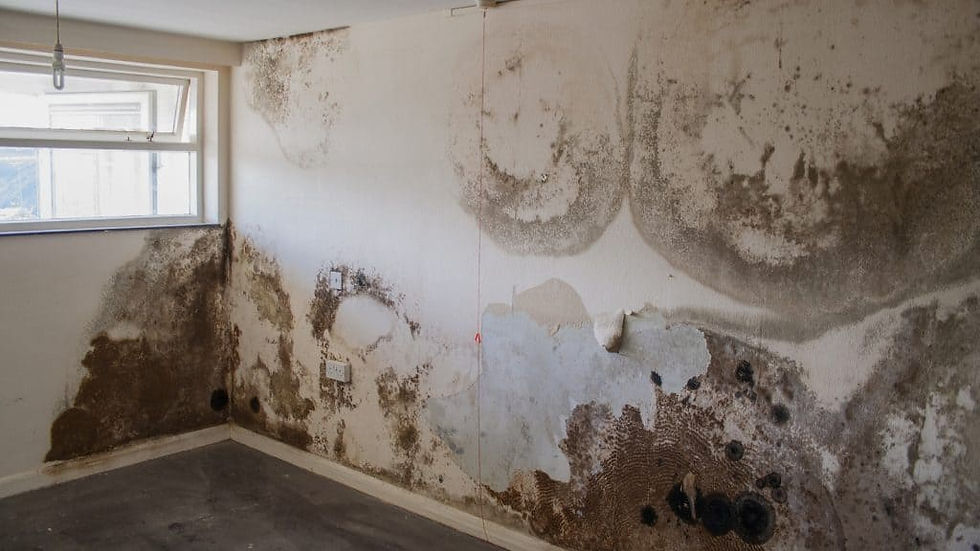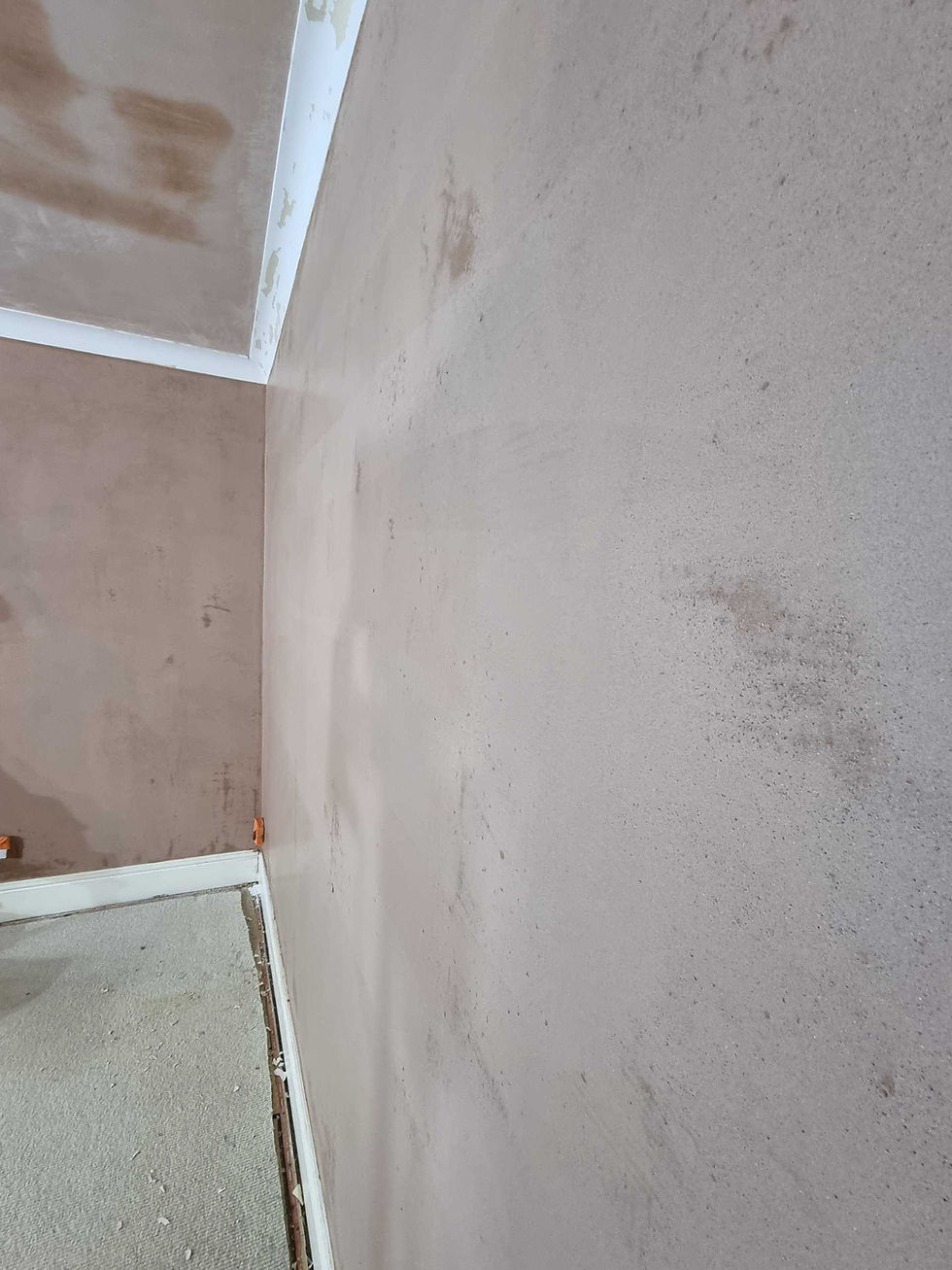Understanding and combatting damp
- Gavin Belton-Rose
- Nov 10, 2023
- 4 min read
Dampness poses a significant challenge to 1 in every 25 homes being at risk of serious problems if the dampness is not dealt with in a timely manner. In this blog, we aim to simplify the understanding of damp, emphasise its importance in addressing, and provide effective strategies to combat this issue.
Understanding Moisture Intrusion: Let's begin by clearly defining dampness. While the term 'damp' broadly refers to something being slightly wet, in the context of housing and buildings, it has a more specific connotation.
Dampness signifies an excess of moisture within a property, either in the air or more commonly on various surfaces like walls and ceilings. Dampness can manifest in three primary types:

1. Ingress of Moisture:
This type occurs when moisture infiltrates the property from external sources, penetrating the roof or walls. Typically, resolving this involves repairing the roof, reconditioning the walls, or applying an exterior coating to enhance protection.
2. Rising Moisture:
Rising dampness is a bit more intricate. It arises when moisture ascends through building materials from the ground via capillary action. The usual solution involves installing or replacing the building's damp-proof course to halt the upward movement of moisture.
3. Condensation Buildup:
Lastly, condensation dampness, often regarded as the most challenging type to manage, occurs without a specific defect and naturally develops when moisture is released within homes during everyday activities such as cooking, washing dishes, bathing, laundry, and even breathing. This type of dampness is increasingly prevalent in UK homes and warrants our focus in this discussion.
Understanding the Significance of Addressing Dampness: Why is addressing dampness essential within the domain of social housing? The answer is straightforward: dampness can have a detrimental impact on the health of individuals residing in or visiting a home.
Primarily, dampness serves as an indicator of excessive humidity within social housing, creating an environment conducive to the survival, proliferation, and spread of germs and viruses.
Moreover, when walls, ceilings, or furniture become damp, they provide an ideal breeding ground for mould growth. Mould releases allergens, irritants, and toxic substances that can lead to respiratory problems, exacerbate existing conditions, and even trigger attacks.
Over time, individuals residing in socially-housed properties with untreated dampness are likely to experience various health impacts, ranging from evident allergic reactions to subtle symptoms like shortness of breath often attributed to the aging process.
This issue is of paramount importance to housing associations and local councils. Social housing aims to provide secure, safe, and affordable accommodation for those in need. When the social housing stock is plagued by dampness, it fails to meet the fundamental criterion of being 'safe.'

Addressing Dampness in Social Housing: As mentioned earlier, the approach to combat dampness varies based on the specific type involved.
Addressing External Moisture Ingress:
To address external moisture ingress, the fundamental approach involves identifying the root cause, effecting necessary repairs, drying out the affected areas, redecorating, and addressing any other issues stemming from water ingress.
Combatting Rising Dampness:
Addressing rising dampness typically necessitates installing or replacing the damp-proof course (DPC), as an inadequate or absent DPC is generally the root cause.
Dealing with Condensation Build-up:
Unlike the other forms of dampness, the root cause of condensation dampness cannot be directly mitigated. Tenants can help by reducing indoor moisture release, such as drying clothes outdoors or using a tumble dryer instead of air-drying clothes on racks. However, as a provider of social housing, you can advise tenants on best practices to reduce indoor humidity. In most cases, additional measures will be necessary.
Implementing Effective Strategies to Combat Dampness:
Enhancing Ventilation: Proper ventilation is crucial to reducing humidity and preventing dampness. It allows airborne moisture to escape before settling on walls, ceilings, or other surfaces. Social housing units should be equipped with extractor fans in kitchens and bathrooms, as well as trickle vents on windows to enhance ventilation. This responsibility should be a priority for housing associations and councils. While tenants can contribute by using extractor fans when necessary and opening windows during activities such as drying clothes or exercising indoors, it's essential to acknowledge the trade-offs, such as energy costs and security concerns.
Utilising Damp-Proofing Measures: Addressing rising dampness isn't limited to installing a damp-proof course. Walls and ceilings can also be safeguarded from condensation using Cork Spray thin internal wall insulation. Applied in two 2mm layers with a final 4mm overskim of plaster, this solution minimally impacts tenants' living space, requiring no adjustments to fixtures or sockets. Once applied, dampness simply cannot form on the surface of internal walls or ceilings.
Taking Action with TIWI Solutions: Dampness often persists even with reduced humidity and improved ventilation. TIWI CorkSpray provides an effective solution for social housing providers, eliminating the need for extensive renovations, rebuilds, or tenant relocations.
Need More Help With Damp?
For more details on our internal wall coating or to request a quote, please feel free to reach out to TIWI CorkSpray at [email protected] or call us at 03331882022.

